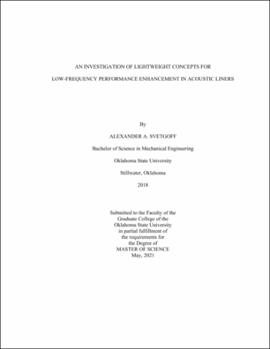| dc.contributor.advisor | Manimala, James | |
| dc.contributor.author | Svetgoff, Alexander A. | |
| dc.date.accessioned | 2021-09-24T13:58:15Z | |
| dc.date.available | 2021-09-24T13:58:15Z | |
| dc.date.issued | 2021-05 | |
| dc.identifier.uri | https://hdl.handle.net/11244/330950 | |
| dc.description.abstract | Acoustic liners are extensively used to reduce noise emitted by aircraft engines. However, conventional acoustic liners are largely ineffective for low-frequency noise content (<~1000 Hz) due to impractical mass and volume requirements. Airborne noise regulations are becoming more and more stringent and new technologies such as ultra-high bypass ratio turbofan engines display a marked increase in low-frequency noise components. In this study, three lightweight and compact, low-frequency acoustic liner concepts - Membrane-Embedded (MEL), Folded Cavity (FCL), and Carbon Foam (CFL) Liners are investigated using normal-incidence impedance tube tests to better understand the mechanisms at work and their potential to deliver practical solutions. In its basic form, MEL is akin to a double degree-of-freedom liner implementing a membrane as septum in lieu of a typical wire mesh. Introducing the membrane provides a thin structural element whose resonance can be tuned to interact with acoustic resonances to enhance absorption bandwidth for the 500-1000 Hz range. Material, geometry, tension, and location of membrane are used as tunable parameters. It is found that by increasing the height of the acoustic cavity below the membrane, the absorption peaks are shifted to lower frequencies. Further, nonuniform cavity geometries allow the creation of multiple absorption peaks for a single membrane tensioning. MEL variants using perforated or mass-loaded membranes and slanted cores are found to provide additional tunability. The experimental results correlated well with COMSOL simulations. FCL utilizes 3D folded cavity cores to pack long acoustic paths into a compact space, thereby generating lower frequency absorption for a given liner volume. A Zwikker- Kosten Transmission Line (ZKTL)-based methodology was used to optimize designs for tonal and broadband low-frequency spectra. Experiments show that absorption peaks below 500 Hz can be engineered within a 1.27 cm thick FCL sample. Finally, CFL configurations employing various carbon foams suitable for multifunctional applications are studied. The influence of parameters such as foam type, thickness, spacing (air gap), and membrane-interaction are evaluated using experiments and simulations. Tailoring the spacing between the foam samples was found to significantly (>~50%) improve mid-range absorption. A low-frequency absorption peak is obtained in the vicinity of the natural frequency (~600 Hz) of the tensioned membrane embedded within the CFL sample, indicating the potential of combining carbon foam-based acoustic bulk absorbers with structurally resonant elements such as the tensioned membrane to bolster low-frequency absorption. Successful transition of these low-frequency liner concepts to applications such as in the aerospace domain could potentially deliver solutions that are congruent with evolving regulatory requirements as well as technological innovations. | |
| dc.format | application/pdf | |
| dc.language | en_US | |
| dc.rights | Copyright is held by the author who has granted the Oklahoma State University Library the non-exclusive right to share this material in its institutional repository. Contact Digital Library Services at lib-dls@okstate.edu or 405-744-9161 for the permission policy on the use, reproduction or distribution of this material. | |
| dc.title | Investigation of lightweight concepts for low-frequency performance enhancement in acoustic liners | |
| dc.contributor.committeeMember | Kara, Kursat | |
| dc.contributor.committeeMember | Gaeta, Richard | |
| osu.filename | Svetgoff_okstate_0664M_17138.pdf | |
| osu.accesstype | Open Access | |
| dc.type.genre | Thesis | |
| dc.type.material | Text | |
| dc.subject.keywords | acoustic liners | |
| dc.subject.keywords | aircraft engine liners | |
| dc.subject.keywords | carbon foam | |
| dc.subject.keywords | folded cavity acoustic liners | |
| dc.subject.keywords | low frequency acoustic liners | |
| dc.subject.keywords | membrane embedded acoustic liners | |
| thesis.degree.discipline | Mechanical and Aerospace Engineering | |
| thesis.degree.grantor | Oklahoma State University | |
